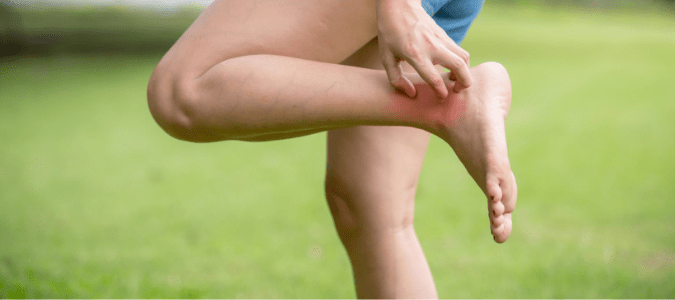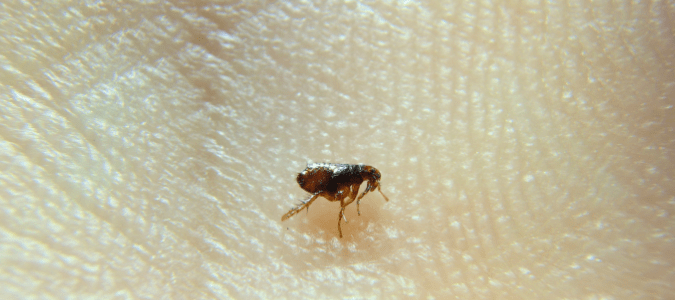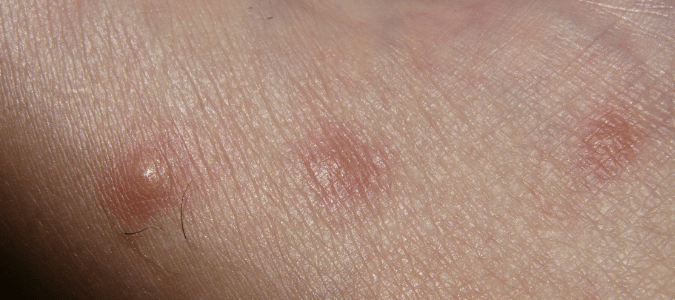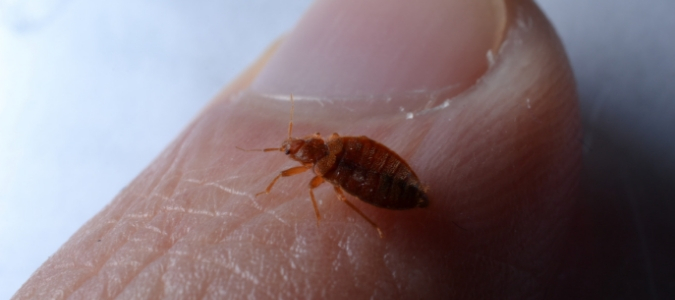
You woke up and noticed weird bites on your body. You look pointedly at Fido as he scratches behind his ear with a little more fervor than usual. Does he have fleas? Or maybe you have bed bugs? How would you know if you have bed bug bites versus flea bites, anyway?
If you’ve struggled to determine exactly what type of bug bit you, you are not alone. Most insect bites result in itching, and many leave a little bump or red mark where you were bitten. Why would it even matter which creature is biting you? For starters, bed bugs and fleas can pose different risks for you, your family and your pets. In this blog post, we’ll review the differences between these bugs’ feeding patterns, what their bites look like and how to treat a bite once you have settled on which creature is responsible.
Fleas: The Most Likely Culprit
A flea bite is probably the most likely among pet owners because fleas prefer furry mammals for hosts. However, you don’t need to have a pet to have a flea problem, and fleas can also feed on humans. That said, for the most part, one of the earliest tell-tale signs of a flea infestation is an irritated or distressed pet. A pet that has fleas will keep on scratching incessantly. On closer inspection (probably by running a flea comb through the pet’s fur) you may be able to find both fleas and their eggs on the animal.
If your pet isn’t treated and the flea population continues to go unchecked, these bugs will leave their hosts and infest other parts of your home, including rugs, carpets and upholstery. Even though fleas can’t fly, they are excellent jumpers. Fleas can also hitch a ride on virtually any animal host and reproduce at a shocking rate. As such, it’s easy for a flea infestation to grow and occupy an entire house.
What do fleas look like? Adults are about an eighth of an inch long, with brown bodies that are flattened sideways. It’s this narrow profile, in fact, that allows fleas to move through animal fur and feathers easily.
Generally speaking, fleas aren’t easy to see, because they’re so small. But in a home with a particularly heavy flea infestation, you might notice them. For example, if you walk on carpet in white socks, you might notice small, dark-colored insects that look like tiny dots which become more prominent against a light background. Once they bite you, fleas latch on and begin sucking blood. Dislodging a flea when it’s feeding is actually quite difficult. Typically, people are bitten by fleas while going about their daily routine at home.
Where do fleas bite? Technically anywhere, but they most often go for:
- Feet
- Ankles
- Legs
- Knees
- Waist
- Armpits
- Elbows
- Other skin folds on your body
You’ll notice most of these locations are closest to the ground. While fleas can’t fly, they are expert jumpers, often capable of traveling up to six inches at a time.
What happens after you are bitten by a flea? This answer varies from person to person. Your immune system will likely respond with intense itching, redness, swelling and your skin could flare up. However, people with heightened sensitivity and allergies towards insect bites may develop serious rashes or hives following a flea bite. The area around the bite may also swell and develop blisters.
Also, while this isn’t pleasant to think about, some fleas can actually burrow into human skin. Tunga penetrans, for instance, is a species of burrowing fleas that infests and digs into the skin of humans, causing an inflammatory skin disease known as tungiasis. Thankfully, you won’t find this species in the U.S.

How To Tell Flea Bites From Other Bites
Are flea bites distinct? Well, yes and no. Flea bites typically:
- Occur around your lower extremities (i.e., the feet, ankles, legs and knees). That being said, they can be found on the rest of the body—especially on a person who’s been cuddling a flea-infested pet.
- Appear as a small, red, itchy bump.
- Have a red “halo” at the center of the bite.
- Are in a haphazard pattern, since these bugs commonly jump from one feeding spot to another. However, this is not always the case. The bites may appear as a linear group of three to four bites.
- Are quite itchy. (But don’t scratch, because this can lead to secondary infection of the bite!)
Though flea-borne diseases are quite rare in the U.S., a flea bite can transmit quite a number of deadly diseases, including Bubonic plague, murine typhus and Tularemia.
How To Treat Flea Bites
Unless secondary infection occurs, a flea bite is typically a self-limiting lesion. That means that in time, a flea bite will disappear on its own without treatment. That being said, flea bites aren’t comfortable—they itch a lot and they can get infected.
How can you help relieve itching and avoid an infection? We typically recommend:
- Cleaning the area around the flea bite with clean water and soap.
- Applying ice or something cold to numb the area, making it less tempting to scratch.
- Applying anti-pruritic (anti-itch) creams to stop the itching.
- Applying topical steroid creams to the area around the bite to reduce the swelling and itching.
- Taking antihistamine medications to treat any associated allergic reactions.
- Refraining from scratching the bite area to avoid secondary infection.
- Taking antibiotic medication if the bite becomes infected.
Additionally, you should likely visit a healthcare facility if:
- The swelling and itching persists for more than a few days.
- There’s discharge from the bite area.
- The bite gets infected.
- You develop a fever following a flea bite.
If you are reasonably sure that you were not bitten by a flea, you might wonder if you were the victim of a bed bug bite.
Bed Bugs: A Homeowner’s Nightmare
Bed bugs are blood-sucking parasites which like to hide in bed frames, mattresses, carpets and box springs, and which are so narrow they can fit into virtually any crack or crevice in your living areas. These pests will come out of these hiding spots when you are sleeping or resting in your bed to feed on your blood. Can you see bed bugs with the human eye? The answer to that question is tricky. These pests like to come out at night, and can hide for long periods of time in between feedings, so if you’re searching during the day, you’ll most likely come up empty.
Typically, a bed bug will bite those parts of your body that are exposed and in contact with your bed. Consequently, the most common locations for bed bug bites include:
- Face
- Arms
- Neck
- Hands
Unlike fleas, bed bugs do not transmit disease-causing pathogens to humans. However, excessive scratching may still lead to secondary infections, and anemia can occur among people living in households with heavy bed bug infestations.
Perhaps the worst part of living in a bed bug-infested home is that the situation can become emotionally and mentally draining. People struggle to sleep because they’re afraid of being bitten. They itch all the time. Many start feeling like bed bugs are everywhere.
This kind of psychological trauma can be especially debilitating for young children. Because of all this, if you believe you have an infestation, you need to implement bed bug control procedures immediately.

How To Tell Bed Bug Bites From Other Bites
There are many bugs that look like bed bugs, but bed bug bites are different from other insect bites in the following ways:
- A bed bug bite is usually a small red spot with a darker red spot at its center.
- The bites will most likely occur while in bed.
- Bed bugs are most likely to bite the face, arms, neck and hands. They may, however, bite other parts of the body as well.
- The bite may be associated with itchiness and a burning sensation.
- People with heightened sensitivity and allergies to insect bites might develop intense papular urticaria.
- Most importantly, a bed bug’s actual bite is painless. The pain and itching usually come moments after the bed bug has bitten you. Because of this, it’s quite rare to catch a bed bug in the act of biting.
Here’s how the itchy papules (bumps) associated with bed bug bites occur:
- Before having a blood meal, a bed bug will secrete an anticoagulant enzyme—salivary apyrase—onto the skin. This makes it easier for these sneaky parasites to get to the blood flow, and also causes the “bump.”
- Once the enzyme has done its job, the bed bug will bite and begin feeding.
- However, if you make any sudden movements while the bed bug is feeding, the creature will often move to a nearby feeding site.
This process is why we tend to see the three or more sequential bites on victims.
How To Treat Bed Bug Bites
Remember how you treated flea bites? Well, how you handle bed bug bites are more or less the same.
Usually, treatment involves:
- Cleaning the area around the bed bug bite with clean water and soap.
- Applying ice or something cold to reduce the itchiness.
- Applying anti-pruritic (anti-itch) creams to stop you from scratching.
- Applying topical steroid creams to the area around the bite to reduce the swelling and itching.
- Taking antihistamine medications to treat any associated allergic reactions.
- Refraining from scratching the bite area to avoid secondary infection.
- Taking antibiotics if the bite becomes infected.
As with any bite, you should always monitor a bed bug bite for signs of an allergic reaction or secondary infection, and consult your physician if the bite symptoms persist or worsen over the next couple of days.
How To Get Rid Of Bed Bugs And Fleas
Of course, the best “treatment” for bug bites is not to get them in the first place. The only way to do this? Eliminate these parasites from your indoor and outdoor home environments. Unfortunately, complete eradication of fleas and bed bugs from a home can be very challenging. It requires a multi-disciplinary pest control approach that utilizes tried and true control methods that also take your health and the environment into consideration.
ABC Can Manage Your Pest Infestations
Especially where bed bugs are concerned, and even when dealing with indoor and outdoor populations of fleas, DIY just doesn’t cut it. So if you’ve got an infestation, get in touch with ABC Home & Commercial Services as soon as possible. We have been helping families with a variety of different pest issues for decades. After we have controlled the pests on your property, our pros will also provide you with guidance on how to keep these pests out for good.


